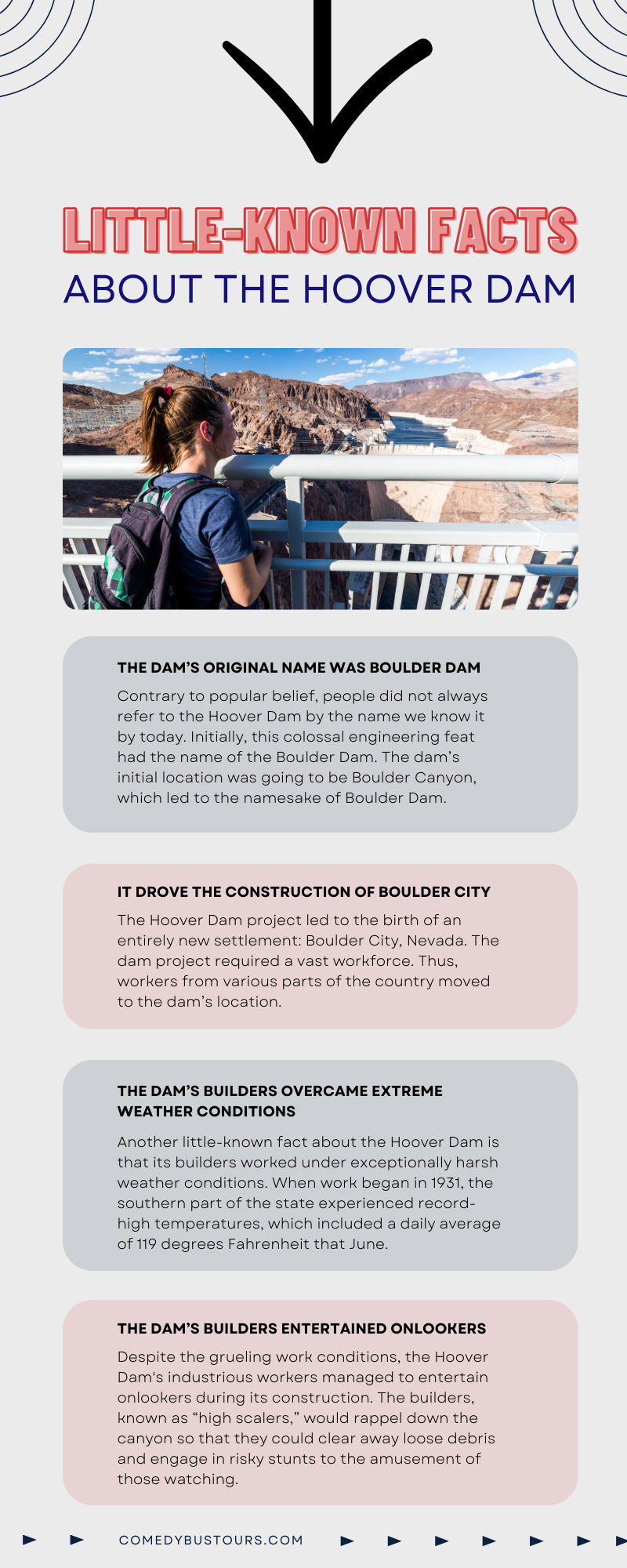Since its completion in 1936, the Hoover Dam has been a subject of fascination. This colossal structure tamed the Colorado River and became a testament to human ingenuity and resilience. Despite its prominence, there are still many important facts about the Hoover Dam that people do not know. Discover seven little-known facts about the Hoover Dam and how these pieces of its story make the dam an even more impressive achievement.
The Dam’s Original Name Was Boulder Dam
Contrary to popular belief, people did not always refer to the Hoover Dam by the name we know it by today. Initially, this colossal engineering feat had the name of the Boulder Dam.
The dam’s initial location was going to be Boulder Canyon, which led to the namesake of Boulder Dam. However, after further surveys and assessments, the proposed site switched its location to Black Canyon.
The name Boulder Dam stuck with the project until 1930, when US Secretary of the Interior Ray Lyman Wilbur said the dam would take the namesake of then-President Herbert Hoover. But during President Franklin D. Roosevelt’s administration, his Secretary of the Interior, Harold Ickes, announced that the dam would go back to its original name.
This led many people to use both names for the dam in the following years. However, that all changed when a congressional resolution made the dam’s current name permanent in 1947.
It Drove the Construction of Boulder City
The Hoover Dam project led to the birth of an entirely new settlement: Boulder City, Nevada. The dam project required a vast workforce. Thus, workers from various parts of the country moved to the dam’s location.
However, at that time, this area lacked adequate facilities to accommodate the influx of workers. The government built Boulder City in 1930 to house these workers and provide essential amenities.
The city, which stood on federal land, had no mayor. Instead, a US Bureau of Reclamation employee managed the town, which initially banned gambling and alcohol. In 1960, the city underwent the incorporation process. To this day, Boulder City stands as a testament to the immense workforce and planning that went into the construction of the Hoover Dam.
The Dam’s Builders Overcame Extreme Weather Conditions
Another little-known fact about the Hoover Dam is that its builders worked under exceptionally harsh weather conditions. When work began in 1931, the southern part of the state experienced record-high temperatures, which included a daily average of 119 degrees Fahrenheit that June.
The unfortunate conditions led to several employees experiencing heatstroke. Despite the relentless sun, the progress on the dam continued, which was a testament to the hard work and endurance of the dam’s dedicated workers.
The Dam’s Builders Entertained Onlookers
Despite the grueling work conditions, the Hoover Dam’s industrious workers managed to entertain onlookers during its construction. The builders, known as “high scalers,” would rappel down the canyon so that they could clear away loose debris and engage in risky stunts to the amusement of those watching. The crew’s risk-takers included employee Louis Fagan, who often helped swing workers to different locations on the canyon walls.
It Was Once the Tallest Dam in the World
When work finished on the Hoover Dam in 1936, it was more than just an engineering marvel. It was also the tallest dam in the world, setting the record by standing a whopping 726 feet high. The Dam’s massive scale was truly awe-inspiring and represented a significant achievement in the field of civil engineering.
However, other structures surpassed the Hoover Dam over the years. For example, Switzerland’s Mauvoisin Dam took the title 20 years later when it stretched to 820 feet in height.
Today, the Hoover Dam is the second tallest dam in the United States, after California’s Oroville Dam, which stands 770 feet. Despite it no longer being the tallest, the Hoover Dam remains a symbol of human ingenuity and the power of ambitious engineering projects.
The Hoover Dam Features a Massive Amount of Concrete
One of the most distinctive factors of the Hoover Dam’s construction is how much concrete builders used for the structure. They needed approximately four million cubic yards to build the dam and other structures and elements. This quantity was enough to construct a two-lane highway that would take you from Miami to the city of Seattle.
This massive use of concrete in the dam’s construction illustrates the enormous scale of the project and the ingenuity and innovation of the engineers who made it possible. Today, the Hoover Dam stands as a testament to the enduring strength of concrete as a building material and the remarkable feats humans can achieve with it.
It Supplies More Than Just Power
Many know the Hoover Dam for its electrical output, but it serves more purposes than just power generation. One of its key roles is in water storage and distribution.
The dam impounds the Colorado River and creates Lake Mead. This vast body of water is a crucial source of irrigation since it supplies water to acres of farmland across California, Nevada, and Arizona.
Besides supplying power and water, the Hoover Dam also plays a significant role in flood control, protecting downstream areas during periods of heavy rainfall. Additionally, by regulating the flow rate of the Colorado River, the dam plays an important role in safety by helping prevent disastrous floods from wreaking havoc on the communities downstream.
In addition to these practical roles, the Hoover Dam has become a significant tourist attraction. Its imposing architecture and the stunning views it offers of Lake Mead and the Colorado River attract visitors each year.
The dam’s Visitor Center provides insights into its history and operation, further enhancing the visitor experience. Therefore, the Hoover Dam’s contributions extend far beyond power generation, offering benefits for many people on multiple fronts.
Now that you know these facts about the Hoover Dam, you are better prepared to pay a visit to it. Contact Comedy on Deck Tours if you want to take our ultimate Hoover Dam comedy bus tour. We will give you a new perspective as you visit this landmark and even take you on a guided tour at the top of the dam itself.



